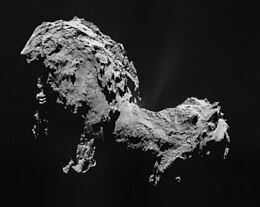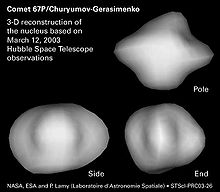丘留莫夫-格拉西缅科彗星
 真实色彩影像,由罗塞塔号摄于2014年9月19日。  根据罗赛塔号的观测数据绘制的彗星电脑模型 | |||||||||||||||||
| 发现 | |||||||||||||||||
|---|---|---|---|---|---|---|---|---|---|---|---|---|---|---|---|---|---|
| 发现者 | 克利姆·伊万诺维奇·丘留莫夫 斯维特拉娜·伊万诺夫娜·格拉西缅科 | ||||||||||||||||
| 发现地 | 苏联哈萨克苏维埃社会主义共和国阿拉木图 | ||||||||||||||||
| 发现日期 | 1969年6月20日 | ||||||||||||||||
| 编号 | |||||||||||||||||
| 其它名称 | 1969 R1, 1969 IV, 1969h, 1975 P1, 1976 VII, 1975i, 1982 VIII, 1982f, 1989 VI, 1988i[1] | ||||||||||||||||
| 轨道参数[1] | |||||||||||||||||
| 历元 2014-Aug-10 (儒略历:2456879.5) | |||||||||||||||||
| 远日点 | 5.6829 AU(850,150,000 km) | ||||||||||||||||
| 近日点 | 1.2432 AU(185,980,000 km) | ||||||||||||||||
| 半长轴 | 3.4630 AU(518,060,000 km) | ||||||||||||||||
| 离心率 | 0.64102 | ||||||||||||||||
| 轨道周期 | 6.44儒略年 | ||||||||||||||||
| 平近点角 | 303.71° | ||||||||||||||||
| 轨道倾角 | 7.0405° | ||||||||||||||||
| 升交点黄经 | 50.147° | ||||||||||||||||
| 近日点参数 | 12.780° | ||||||||||||||||
| 物理特征 | |||||||||||||||||
| 大小 | 直径: 4.1×3.2×1.3 km(2.55×1.99×0.81 mi) 半径: 2.5×2.5×2 km(1.6×1.6×1.2 mi)[2] | ||||||||||||||||
| 质量 | (1.0±0.1)×1013 kg[3] | ||||||||||||||||
| 平均密度 | 0.4 g/cm³[2] | ||||||||||||||||
| 估计为1 m/s(3 ft/s)[4] | |||||||||||||||||
| 自转周期 | 12.4043±0.0007 h[5] | ||||||||||||||||
| 北极赤经 | 69.00°[2] | ||||||||||||||||
| 北极赤纬 | 64.00°[2] | ||||||||||||||||
| |||||||||||||||||
丘留莫夫-格拉西缅科彗星[6](俄语:Комета Чурюмова — Герасименко),官方命名为67P/丘留莫夫-格拉西缅科,是一颗轨道周期为6.45年[1],自转周期为12.4小时的彗星[5]。它于2015年8月13日到达近日点[7]。与所有彗星一样,它的名字取自发现者。此彗星为在1969年由苏联天文学家克利姆·伊万诺维奇·丘留莫夫与斯维特拉娜·伊万诺夫娜·格拉西缅科发现。
它是欧洲空间局于2004年3月2日发射的罗塞塔号探测器的目标天体[8][9][10]。2014年8月6日,罗塞塔号探测器与彗星太空会合[11][12],并在同年9月10日进入预定轨道[13],接着的11月12日,其携带的菲莱登陆器成功在彗星上着陆。这是有史以来第一次有人造探测器在彗核上受控软着陆[14][15]。
发现
67P是由克利姆·伊万诺维奇·丘留莫夫于1969在基辅大学天文台发现的[16]。他在查看斯维特拉娜·伊万诺夫娜·格拉西缅科于1969年9月11在阿拉木图天体物理研究所拍摄的周期彗星32P/科马斯·索拉彗星的照片时,发现在底片边缘处有一个类似彗星的天体,但是最初他认为这就是拍摄的32P彗星[17]。
回到母校之后,丘留莫夫又仔细检查了所有的照片。10月22日,他发现那个天体偏离了预期位置达1.8度,所以不可能是科马斯·索拉彗星。再仔细观察后,在照片上发现了一个暗淡的32P彗星的影像,因此丘留莫夫断定这是一个新发现的彗星[17]。
“罗塞塔”任务
探测丘留莫夫-格拉西缅科彗星为罗塞塔号的任务,此计划在2004年公布,并在2014成功登陆彗星,是有史以来第一次有人造探测器降落在彗核上[14]。
前期

为了给罗塞塔任务提供数据,哈勃太空望远镜在2003年3月12日对丘留莫夫-格拉西缅科彗星进行了拍摄[18]。
2014年6月6日,丘留莫夫-格拉西缅科彗星被检测到以大约1 L/s(0.26 USgal/s)的速度释放出水蒸气,当时彗星距罗塞塔号360,000 km(220,000 mi),而太阳方面则距3.9 AU(580,000,000 km)[19][20]。在2014年7月14日,罗塞塔号拍摄到其彗核为不规则的形状,且形状上有两个不同的部分。一种解释是,它是由密接小行星之间的碰撞而形成。但亦存在其它的形成情况,例如它可能为被其他星体的引力影响所致,又或是彗星表面曾经拥有大量的冰,但已经全数升华而留下的非对称形状。估计核的大小应有3.5×4 km(2.2×2.5 mi)[10][21][22]。
会合与进入轨道

2014年5月,罗塞塔号使用推进器,将自身的速度由780 m/s(2,800 km/h;1,700 mph)开始逐渐减少[10][23],这是为了通过减小罗塞塔号的相对速度至1 m/s(4 km/h;2 mph),以为同年8月6日进入彗星的预定轨道作准备[11][12]。9月10日,罗塞塔号进入预定轨道,并离彗核只有30 km(19 mi)[11][12][24]。
着陆
2014年11月12日,罗塞塔号运载的菲莱登陆器登陆丘留莫夫-格拉西缅科彗星。菲莱登陆器为重约100千克(220磅)的空间探测器,在罗塞塔号降落后即会用起落架把其放下[10][25]。登陆器的名字则为取自阿祖奇亚岛上的菲莱神庙,该岛屿在阿斯旺水坝的兴建中部分淹没,而菲莱神庙也被逼拆迁[26]。另外,丘留莫夫-格拉西缅科彗星的表面的引力只有10^-3 m/s2[27],为地球的约万分之一。
由于彗星上的引力太小,“菲莱”很容易便会因反弹而坠机,因此必须考虑一些技术因素,以保持登陆器的平稳。所以登陆器的起落架便根据机构学来设计,以便应对丘留莫夫-格拉西缅科彗星表面较小的引力。另外考虑的也包括鱼叉、推进器、用作旋紧彗星表面上的冰的着陆臂和以防止在登陆器在彗星表面附近自转的飞轮[28][29][30]。尽管如此,登陆器在第三次着陆才会稳定在彗星表面的安全位置(本来计划是一次降落成功的)[31][32]。
轨道历史
一般情况下彗星在接近木星或土星时都会改变其轨道。1959年以前,丘留莫夫-格拉西缅科彗星的近日点距离为2.7 AU(400,000,000 km)。1959年2月,它与木星近距离接触[33],导致它的近日点向内移动了大约1.3 AU(190,000,000 km),并进入了现在的轨道[34]。
在2009年的近日点后,观察家发现它的自转周期已经从12.76小时减少至12.4小时。据信这一变化是因为升华引起的扭矩而导致[5]。
2015年的近日点
截至2014年8月[update],丘留莫夫-格拉西缅科彗星的彗核会有大约20视星等[35]。并在接下来的2015年8月13日过近日点(最接近太阳)[7]。从2014年12月至2015年9月,它将有一个小于45度的距角[36]。在2015年2月10日,丘留莫夫-格拉西缅科彗星会出现于离太阳5度的位置,并在地球观察的时候出现彼此非常靠近的现象[36]。在近日点之后,它可能只亮约11视星等[7]。
画廊
参考资料
- ^ 1.0 1.1 1.2 JPL Small-Body Database Browser: 67P/Churyumov-Gerasimenko. NASA/Jet Propulsion Laboratory. 5 October 2013 [21 January 2014]. (原始内容存档于2013-02-15).
- ^ 2.0 2.1 2.2 2.3 Baldwin, Emily. Measuring Comet 67P/C-G. European Space Agency. 6 October 2014 [7 October 2014]. (原始内容存档于2014-12-06).
- ^ Baldwin, Emily. Determining the mass of comet 67P/C-G. European Space Agency. 21 August 2014 [21 August 2014]. (原始内容存档于2014-11-09).
- ^ Dambeck, Thorsten. Expedition to primeval matter. Max-Planck-Gesellschaft. 21 January 2014 [19 September 2014]. (原始内容存档于2019-12-20).
- ^ 5.0 5.1 5.2 Mottola, S.; Lowry, S.; Snodgrass, C.; Lamy, P. L.; Toth, I.; et al. The rotation state of 67P/Churyumov-Gerasimenko from approach observations with the OSIRIS cameras on Rosetta. Astronomy and Astrophysics. September 2014, 569. L2. Bibcode:2014A&A...569L...2M. doi:10.1051/0004-6361/201424590.
- ^ 郭洋. “罗塞塔”追星之旅回眸与展望. 新华社. 2014-11-12 [2014-11-19]. (原始内容存档于2014-11-15).
- ^ 7.0 7.1 7.2 Yoshida, Seiichi. 67P/Churyumov-Gerasimenko. Aerith.net. 30 December 2010 [9 February 2012]. (原始内容存档于2019-12-02).
- ^ Krolikowska, Malgorzata. 67P/Churyumov–Gerasimenko – potential target for the Rosetta mission. Acta Astronomica. 2003, 53: 195–209. Bibcode:2003AcA....53..195K. arXiv:astro-ph/0309130
 .
.
- ^ Agle, D. C.; Cook, Jia-Rui; Brown, Dwayne; Bauer, Markus. Rosetta: To Chase a Comet. NASA. 17 January 2014 [18 January 2014]. Release 2014-015. (原始内容存档于2016-11-13).
- ^ 10.0 10.1 10.2 10.3 Chang, Kenneth. Rosetta Spacecraft Set for Unprecedented Close Study of a Comet. The New York Times. 5 August 2014 [5 August 2014]. (原始内容存档于2014-08-07).
- ^ 11.0 11.1 11.2 Fischer, D. Rendezvous with a crazy world. The Planetary Society. 6 August 2014 [6 August 2014]. (原始内容存档于2014年8月6日).
- ^ 12.0 12.1 12.2 Bauer, M. Rosetta Arrives at Comet Destination. European Space Agency. 6 August 2014 [6 August 2014]. (原始内容存档于2014年8月6日).
- ^ Scuka, Daniel. Down, down we go to 29 km – or lower?. European Space Agency. 10 September 2014 [20 September 2014]. (原始内容存档于2017-10-11).
- ^ 14.0 14.1 Chang, Kenneth. European Space Agency’s Spacecraft Lands on Comet’s Surface. New York Times. 12 November 2014 [12 November 2014]. (原始内容存档于2014-11-12).
- ^ Probe makes historic comet landing. BBC news. 12 November 2014 [12 November 2014]. (原始内容存档于2014-11-13).
- ^ Klim Ivanovich Churyumov. International Astronomical Union. [8 August 2014]. (原始内容存档于2016-04-10).
- ^ 17.0 17.1 Kronk, Gary W.; et al. 67P/1969 R1 (Churyumov-Gerasimenko). Cometography: A Catalog of Comets; Volume 5: 1960-1982. Cambridge University Press. 2010: 241–245 [2014-11-13]. ISBN 052187226X. (原始内容存档于2016-12-30).
- ^ Buckley, Michael; Villard, Ray; Christensen, Lars. Hubble Assists Rosetta Comet Mission. HubbleSite.org. 5 September 2003 [2014-11-13]. (原始内容存档于2016-07-06).
- ^ Baldwin, Emily. First Detection of Water from 67P/C-G. European Space Agency. 23 June 2014 [23 June 2014]. (原始内容存档于2014-06-26). Sungrazer Comets (页面存档备份,存于互联网档案馆)
- ^ Agle, D. C.; Brown, Dwayne; Bauer, Markus. Rosetta's Comet Target 'Releases' Plentiful Water. NASA. 30 June 2014 [30 June 2014]. (原始内容存档于2022-03-25).
- ^ The twofold comet: Comet 67P/Churyumov-Gerasimenko. Astronomy.com. 17 July 2014 [18 July 2014]. (原始内容存档于2022-03-10).
- ^ Temming, Maria. Rosetta's Comet has a Split Personality. Sky & Telescope. 17 July 2014 [18 July 2014]. (原始内容存档于2019-08-13).
- ^ Gannon, Megan. Comet-chasing Euro-probe could make history Wednesday. Christian Science Monitor. 4 August 2014 [6 August 2014]. (原始内容存档于2022-02-11).
- ^ Lakdawalla, Emily. Finding my way around comet Churyumov-Gerasimenko. The Planetary Society. 15 August 2014 [15 August 2014]. (原始内容存档于2014年8月15日).
- ^ Chang, Kenneth. Philae Lander Nears a Cosmic Touchdown. New York Times. 10 November 2014 [11 November 2014]. (原始内容存档于2022-02-11).
- ^ Amos, Jonathan. Rosetta comet mission: Landing site named 'Agilkia'. BBC News. 4 November 2014 [9 November 2014]. (原始内容存档于2022-02-11).
- ^ Hilchenbach, M. Simulation of the Landing of Rosetta Philae on Comet 67P/Churyumov-Gerasimenko (PDF). SIMPACK User Meeting. 9–10 November 2004. Wartburg/Eisenach, Germany.: 25. 2004 [6 August 2014]. (原始内容 (PDF)存档于2014-11-26).
- ^ Ellis, Ralph. pace probe scores a 310-million-mile bull's-eye with comet landing. CNN. 13 November 2014 [13 November 2014]. (原始内容存档于2014-11-14).
Comet 67P has a very weak gravity, so anchoring harpoons were designed to shoot into the comet to fix the spacecraft to the surface.
- ^ Parnell, Brid-Aine. BOUNCY BOUNCY: Comet probot Philae may have landed TWICE. The Register. 12 November 2014 [13 November 2014]. (原始内容存档于2014-11-15).
Philae’s flywheel was part of its landing gear and stopped the craft from rotating while it was operational,
- ^ O'neill, Ian. Rosetta's Lander Grabs Onto Comet and Lands. Discovery News (Discovery Channel). 12 November 2014 [2014-11-14]. (原始内容存档于2014-11-15).
harpoons, landing leg ice screws and thrusters needed to work in concert to ensure Philae stayed in place.
- ^ Agle, DC; Brown, Dwayne; Bauer, Markus. Rosetta's Comet Lander Landed Three Times. NASA. 13 November 2014 [13 November 2014]. (原始内容存档于2014-11-29).
- ^ Staff. Rosetta's Frequently Asked Questions. European Space Agency. 2014 [12 November 2014]. (原始内容存档于2014-07-09).
- ^ JPL Close-Approach Data: 67P/Churyumov-Gerasimenko. NASA/Jet Propulsion Laboratory. 29 June 2010 [9 February 2012]. (原始内容存档于2021-02-14).
- ^ Kinoshita, Kazuo. 67P/Churyumov-Gerasimenko. Comet Orbit. 7 May 2009 [25 April 2009]. (原始内容存档于2019-05-20).
- ^ 67P/Churyumov-Gerasimenko. Minor Planet Center. [17 June 2014]. (原始内容存档于2017-09-30).
- ^ 36.0 36.1 Elements and Ephemeris for 67P/Churyumov-Gerasimenko. Minor Planet Center. [9 August 2014]. (原始内容存档于2014年11月4日).
- ^ VLT Tracks Rosetta's Comet. European Southern Observatory. 8 September 2014 [8 September 2014]. (原始内容存档于2021-02-20).
延伸阅读
- 阿加瓦尔, 洁西卡; et al. 2004年和2006年之間,丘留莫夫-格拉西缅科彗星的足跡. 伊卡洛斯. June 2010, 207 (2): 992–1012. Bibcode:2010Icar..207..992A. arXiv:1001.3775
 . doi:10.1016/j.icarus.2010.01.003.
. doi:10.1016/j.icarus.2010.01.003.
外部链接
- 67P/Churyumov–Gerasimenko(页面存档备份,存于互联网档案馆)-由Cometography.com提供
- 67P/Churyumov-Gerasimenko. [2012-03-15]. (原始内容存档于2007-11-11).-由加那利群岛天体物理学提供
- 67P pronunciation guide(页面存档备份,存于互联网档案馆) 由欧洲空间局提供
- 文章
- "Rosetta's Target: Comet 67P/Churyumov-Gerasimenko"(页面存档备份,存于互联网档案馆)-由欧洲空间局提供
- "Mission to Land on a Comet"(页面存档备份,存于互联网档案馆)-由美国宇航局提供
- 媒体
- 67P multimedia gallery-由欧洲空间局提供
- 67P color image(页面存档备份,存于互联网档案馆)-由Astrometrica.at提供
- 67P size comparison(页面存档备份,存于互联网档案馆)
- Comet images(页面存档备份,存于互联网档案馆)-纽约时报,2014年11月11日
- ESA - Rosetta: landing on a comet(页面存档备份,存于互联网档案馆)
- ESA - Live Webcasts of Comet Landing & Latest Status Reports.(页面存档备份,存于互联网档案馆)
- YouTube上的Video and photos from landed spacecraft
| 周期彗星 | ||
|---|---|---|
| 前一颗彗星 66P/杜托伊特彗星 |
丘留莫夫-格拉西缅科彗星 | 后一颗彗星 68P/凯莫拉彗星 |
| 周期彗星列表 | ||
Text is available under the CC BY-SA 4.0 license; additional terms may apply.
Images, videos and audio are available under their respective licenses.
![由甚大望远镜拍摄的影像,摄于2014年8月11日。[37]](https://upload.wikimedia.org/wikipedia/commons/thumb/e/ed/VLT_Tracks_Rosetta%27s_Comet.jpg/327px-VLT_Tracks_Rosetta%27s_Comet.jpg)





